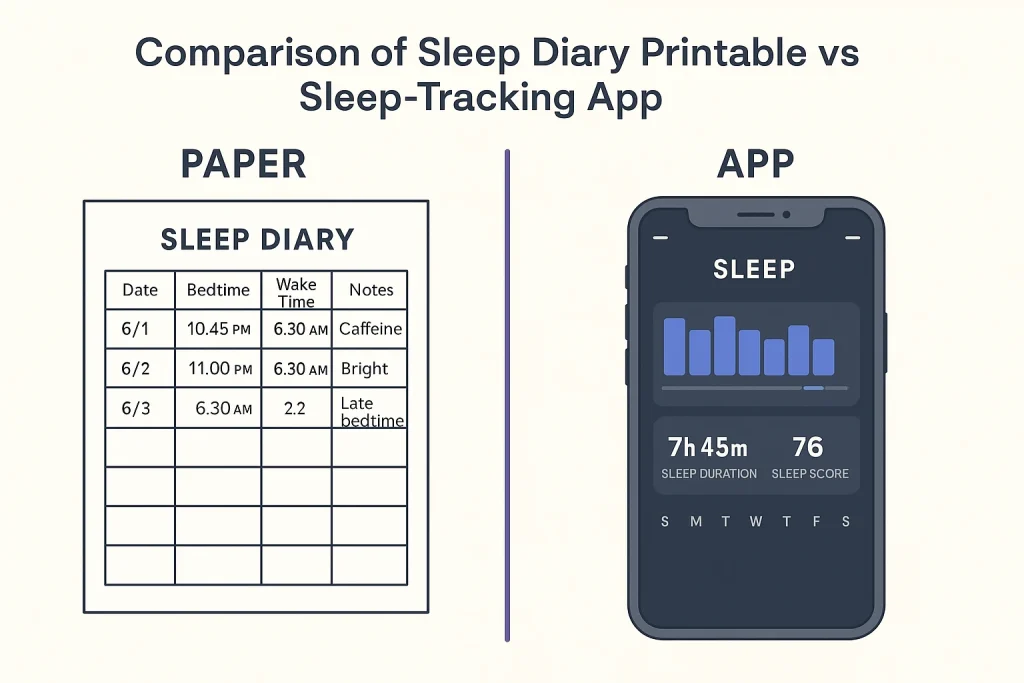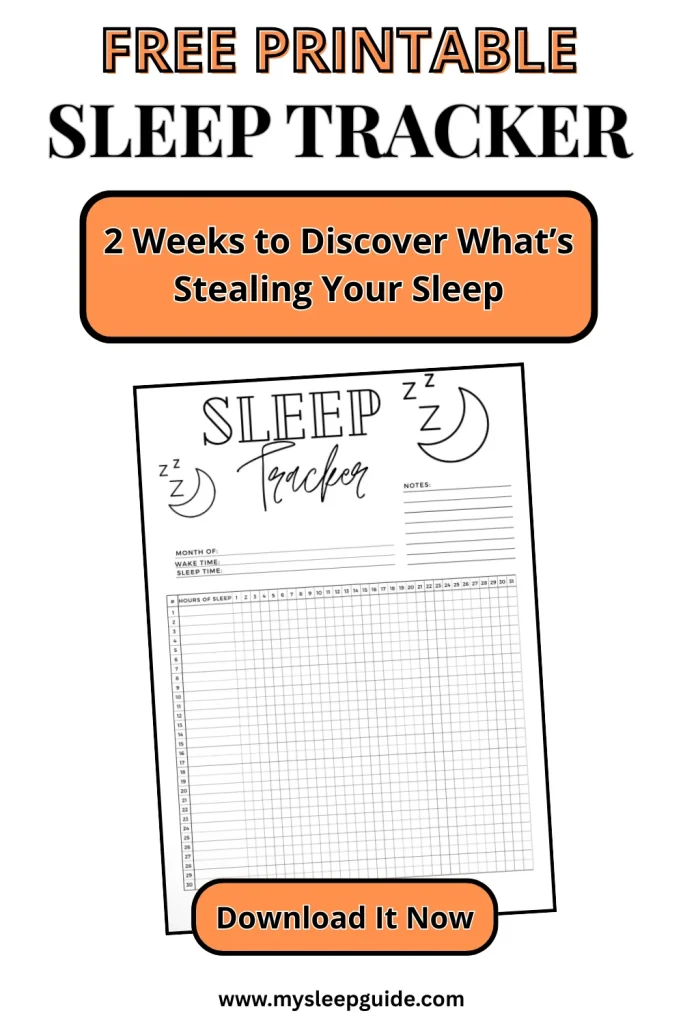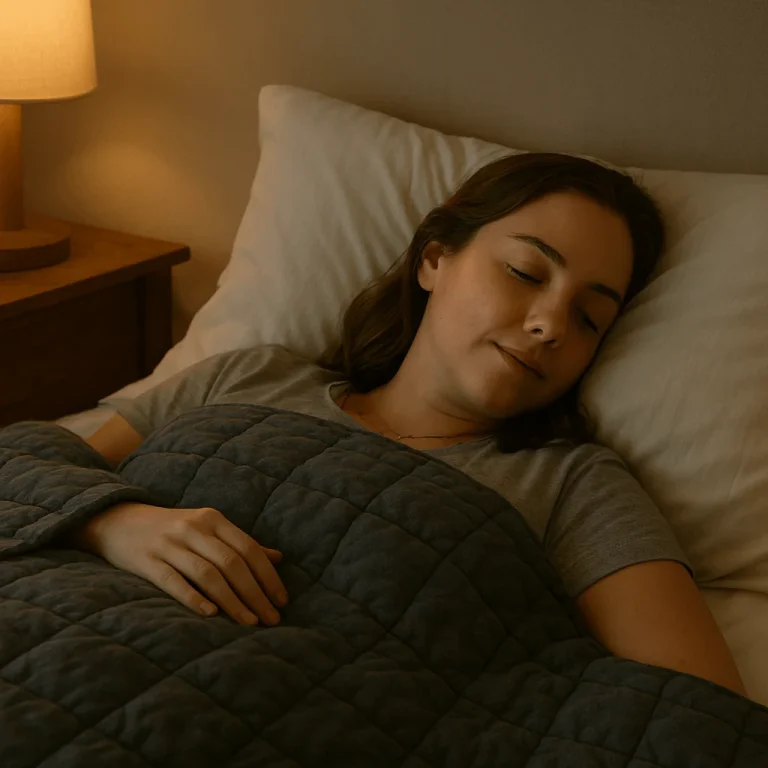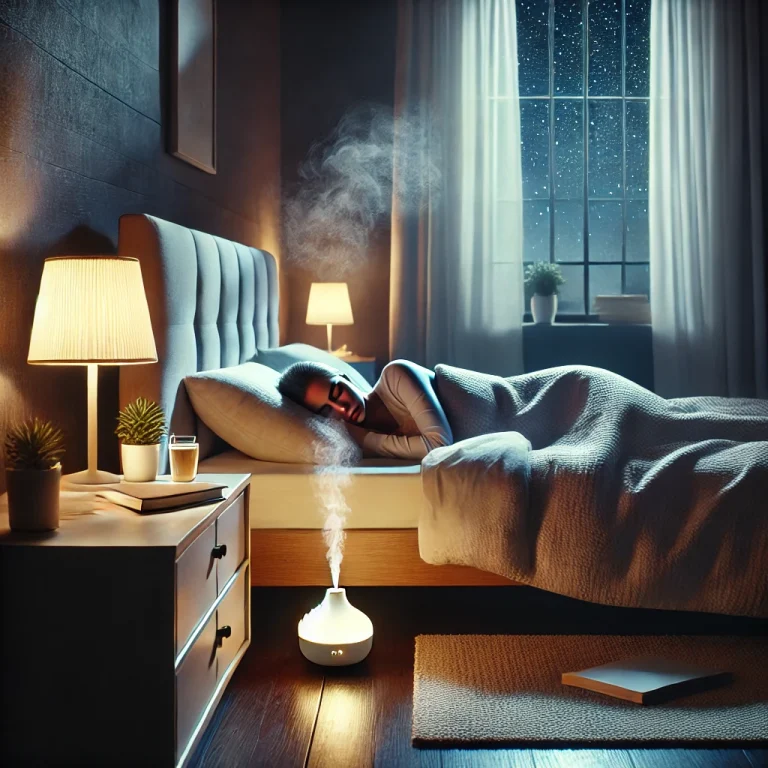Free Printable Sleep Tracker – 14-Night Log Template
Still waking up foggy even after “eight hours”? A printable sleep tracker gives you objective answers. Over the next few minutes, you’ll learn how to use a two-week sleep log to record bedtime, wake-up time, and the habits that shape your nights. We’ll cover what’s on the sheet, how to fill it out, and—most important—how to turn those numbers into smarter tweaks. By the end, you’ll download your free sleep log and know exactly how to use it to improve your sleep tonight.
Why Track Your Sleep?
Paper tracking turns vague guesses into data you can actually act on.
Spot Trends You’d Never Notice
- Bedtime drift: Even a 30-minute slide can cost an entire REM cycle.
- Weekend rebound: Sleeping late on Sunday often triggers “social jet lag” Monday.
- Hidden disruptors: Late caffeine or screen glare lines up neatly with low-quality scores—proof you can’t ignore.
Turn Data into Action
- Count consistency, not just hours – A steady bedtime and wake-up time matter more than chasing perfect numbers. Six solid hours often beat seven broken ones.
- Link habits to outcomes – Use the Notes section to track habits like exercise, caffeine, alcohol, or stress. Then compare those notes with your sleep quality the next morning.
- Change one variable at a time – Shift just one factor—like moving your last cup of coffee earlier—so you can clearly see what helped (or didn’t).
Numbers replace assumptions. Tracking shows exactly which habit to tackle first.
What’s Inside This Printable Sleep Tracker PDF

Printable sleep tracker with rows for each day of the week and simple columns to log bedtime, wake-up time, total hours slept, sleep quality, dreams, and quick notes—one weekly log per page.
Each weekly sheet gives you just the essentials: no clutter, no overcomplication. You’ll capture the details that actually impact sleep without “tracker fatigue.”
You’ll fill in your bedtime, wake-up time, and total hours of sleep. You’ll also rate your sleep quality from 1 to 5, check off whether you remembered dreaming, and jot a quick note—like what helped or hurt your sleep.
It takes less than a minute to complete and makes sleep patterns easy to spot at a glance.
Printer-Friendly Design
- Sizes: US Letter (8.5″ × 11″) and A4
- One week per page for easy viewing
- Extra space on the left side so you can punch holes and keep it in a binder
- Best printed in color to clearly see column labels and layout highlights
How to Use Your Printable Sleep Tracker: Step-by-Step Guide
- Print & Prep – Download the PDF, print two copies, and leave them on your nightstand with a pen.
- Baseline Week – For seven nights, make zero changes; just record the facts.
- Log the data – Write your bedtime, wake-up time, total hours, and a quick note. Rate your sleep and mark dreams if remembered.
- Tweak One Variable – Drop late-day coffee or move screens earlier, but not both.
- Review on Sunday – Place Week 1 and Week 2 sheets side by side. Did sleep quality rise? Are you sleeping longer?
Isolate, test, and review. Your sleep log works best when you change one factor at a time and measure the result.
For a deeper look at best practices, see this guide on how to keep a sleep diary
Printable Sleep Tracker vs. Apps: Which Works Best?

Why Paper Still Wins
Choosing a paper sleep diary printable keeps screens—and their melatonin-disrupting blue light—out of the bedroom. A physical sheet on your nightstand also acts as a constant, tactile reminder to log each night, and because you can view two full weeks at once, patterns jump out without any scrolling.
When an App Makes Sense
An app shines when you want automatic heart-rate and movement data, longer month-over-month trend lines, and smart bedtime alerts that nudge you if your routine drifts. These features add depth to your analysis, especially after you’ve mastered the basics with paper tracking.
Hybrid Approach
Start with the printable to build awareness, then add an app for richer data once you’ve mastered the basics. Compare both sets of numbers every Sunday.
Pick the tool you’ll use consistently— that’s what improves sleep.
6 Data-Driven Tips to Improve Your Numbers
1. Standardize Lights-Out:
Keep bedtime within a 30-minute window—even on weekends. A consistent routine helps your body anticipate sleep, leading to more refreshing rest.
👉 Use the Bedtime column to watch for drift and tighten your window.
2. Catch Morning Sunlight
Spend 10–15 minutes outside soon after waking. Daylight helps reset your internal clock, making it easier to fall asleep the next night.
👉 In your Notes, jot “sunlight ✔” each morning to track the habit.
3. Set a Caffeine Cut-Off
Stop coffee or tea around 7 hours before bed to avoid stimulant interference.
👉 Record your last cup time in the Notes, and compare with your sleep quality the next morning.
4. Cool the Room (60–67 °F or 16–19 °C)
Your body needs to cool down to fall asleep. Lower the thermostat or crack a window.
👉 If you notice restless sleep, log the room temp in the Notes to see if heat played a role.
5. Add a 20-Minute Wind-Down
Gentle stretching, calming breathwork, or light reading before bed helps quiet your nervous system.
👉 Make a habit of writing “wind-down ✔” in the Notes—then check if sleep quality improves.
6. Move Heavy Workouts Earlier
Intense exercise close to bedtime can spike cortisol and delay sleep.
👉 Log your workout end-time in the Notes. If late workouts match poor sleep scores, try shifting them earlier.
Let the tracker guide your tweaks: change one thing, observe the result, and keep what works.
Related Posts:
- How to Personalize Your Nighttime Routine for Maximum Sleep Quality
- 5 Proven Mental Exercises for Sleep That Actually Work
Download Your Free Printable Sleep Tracker (PDF)
📄 Download Your Free Sleep Tracker →
Quick Print & Setup
- One weekly log per page
- Includes space for quick notes and habit tracking
- Designed for A4 and US Letter printers
- Best printed in color for maximum clarity
How to Log Each Night
- Fill in the basics: Write your bedtime, wake-up time, and total hours of sleep.
- Rate your sleep: Use the 1–5 scale to track quality.
- Mark dreams: Check off yes or no if you remembered a dream.
- Jot quick notes: Add a word or two about anything that stood out—like stress, screens, or a new tea.
With two weekly pages, you can see your full two-week progress at a glance.)
I use this tracker myself. Every Sunday, I print two copies—one for the week ahead, one as backup—and slide one under my phone on the nightstand. Each night, I jot down my bedtime, wake-up time, and how many hours I actually slept. If I remember a dream, I mark it. Over time, I started noticing clear patterns. Nights with screens past 10 p.m.? Lower sleep quality. A calm wind-down? Much better numbers the next morning. The log made it obvious—so I knew exactly what to change.
Putting It All Together
Get the Sleep Tracker Printable here
You now have:
- A printable tracker ready to record two weeks of data
- A simple five-step process to isolate and test sleep-disrupting habits
- Six targeted tweaks to raise your nightly quality score
Write down your target bedtime, place the sheet on your nightstand, and make your first entry tonight. After two weeks, compare results and choose the next habit to refine.
Consistency—not complexity—is what unlocks deeper, more dependable sleep.
Frequently Asked Questions
How often should I fill out the sleep log?
You should fill out the sleep log every morning, ideally within ten minutes of waking.
How do I shade partial hours?
To shade partial hours on the sleep log, color half the box for 30 minutes or a quarter of the box for 15 minutes.
Can kids or teens use this diary?
Yes. Kids and teens can use the sleep diary by labeling the days for their schedule and shading the timeline the same way adults do.
What if my schedule changes weekly?
If your sleep schedule changes weekly, use the Notes column to mark shift work or travel and watch for recurring trouble spots.
Do I still need an app if I use this sheet?
You don’t need an app when you start using the sleep log. Begin with the sheet alone, then add an app later if you want heart-rate or REM data.







